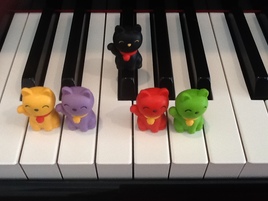Once students are comfortable with identifying notes by ear that step up, step down, and repeat, it is time to introduce skips!
One of my favorite warm-ups for beginning students is to have them play a five-finger scale stepping up and down, then skipping up and down. This is a great way to get students listening for the difference between steps and skips. As they play, use your hands to show how far apart the notes are. Then, trade places and have students gesture the notes while you play the piano. Encourage students to sing the pattern as well, to feel the difference between singing a step and singing a skip.
Next, sing a few familiar melodies that use skips, using your hands to show the intervals. “This Old Man” and “Do, Re, Mi” (from The Sound of Music) are both good choices that use both ascending and descending skips.
Finally, test your students by playing a listening game! Sing or play two notes and ask students to determine whether they are stepping or skipping. If you use an iPad or computer in your lessons, there are ear training apps that will play an interval for your students and ask them to name it; I like the “Interval Ear Training” exercise in the Tenuto app (which can also be found for free online at www.musictheory.net).
For an extra challenge, check out my “Play by Ear Challenge” worksheets, which ask students figure out a phrase from a familiar melody by ear and notate it on the staff. Worksheet #2 focuses on steps and skips. Find all of my free resources here.
Do you have any tips for teaching your students to identify steps and skips by ear? Please leave a comment below!


 RSS Feed
RSS Feed